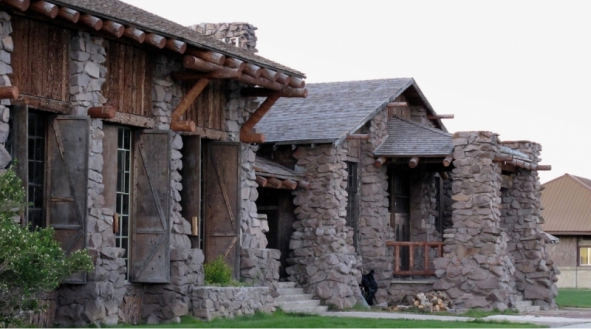- The Yellowstone Caldera encompasses nearly one third of the total area of Yellowstone National Park.
- The Yellowstone Caldera is 45 miles long and 28 miles wide.
- Many of the features of Yellowstone National Park, including the Grand Canyon of the Yellowstone and Yellowstone Lake are related to the volcanic eruption and subsequent formation of the Yellowstone Caldera.
How was the Yellowstone Caldera formed?
During the last eruption, 600 cubic miles of volcanic rock was spewed into the air (2,400 times as much as Mount St. Helen's). Yellowstone ash has been found in Ventura, California to the west and in Iowa to the east.
After the eruption, the magma chamber had emptied and large sections of the magma chamber roof collapsed. This triggered a chain reaction of collapses that produced a caldera 45 miles long and 28 miles wide. The Yellowstone Caldera is hence a large basin-shaped volcanic depression that is more or less circular in form.
Why are there so many geothermal features within the park today?
Once a land covered almost entirely by mountains, the collapsed volcano (or Caldera) covers nearly one third of the park and is now characterized by low rolling plateaus. The Grand Canyon of the Yellowstone and Yellowstone Lake are also remnants of the volcano and collapsing caldera. Heat from the enormous reservoir of molten rock remains deep within the earth beneath Yellowstone, sustaining the spectacular phenomena for which the Park is so famous.
Where can I see the rim of the Yellowstone Caldera?
The surrounding rim of the ancient Yellowstone caldera is composed of many mountains rising to over 9,000 feet, and they provide plenty of alpine scenery. Anywhere that you go in Yellowstone, you have only to look into the horizon and note the rise of the mountains to see the remnants of the caldera rim.
- Yellowstone Lake
Yellowstone Lake fills the eastern part of the caldera and offers opportunities for boating and fishing expeditions in the summer. - Lake Overlook Trail
The trail begins at a trailhead maker near the entrance of the West Thumb Geyser Basin parking area and climbs through a mountain meadow to a commanding view of the West Thumb of Yellowstone Lake and the surrounding Absaroka Mountains. Moderate difficulty. 2 miles round-trip. - Elephant Back Mountain
The trail begins at a turnout 1 mile south of the Fishing Bridge Junction and then climbs through a lodge pole pine forest. At the junction of two trails, you can take either trail to a panoramic view of Yellowstone Lake, Pelican Valley and the Absaroka Mountains. Moderate to difficult. 3 miles round-trip. - Pelican Creek
Take the trail starting at the west end of Pelican Creek bridge, 1.0 mile east of the Fishing Bridge Visitor Center, and travel this diverse, easy trail through forest, along lake shore, and across a marshy area via boardwalks. Easy. 1 mile roundtrip. - Storm Point
Starting at a large turnout at Indian Pond, 3 miles east of the Fishing Bridge Visitor Center, this level loop crosses meadow and forest before reaching the tip of Storm Point, where you will find expansive views of Yellowstone Lake and surrounding mountains. The trail will continue back along the lakeshore and through a lodge pole pine forest before rejoining the road. Easy to moderate. 3 miles round-trip.
Learn More
- Visit any of the Park’s Visitor Centers like the Old Faithful Visitor Education Center, explore the exhibits, and view the various information videos.
- Participate in a ranger-led activity to learn more about the formation of and the current day remnants of Yellowstone National Park caldera.






